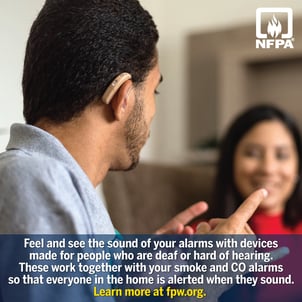
Sound is a sense many of us rely on daily. We rely on it when we wake up to our alarm, we rely on it when we are driving. But what if you could not depend on sound? Sound is what ties us safely to the world around us. It is what alerts us in the event of an emergency. It tells us there is smoke in the building or home and that a fire may be near.
According to the National Institute of Health, one in eight people in the U.S. – or 13 percent of the U.S. population – aged 12 and older has hearing loss in both ears. That is a significant number when you think about it. So how do people who are deaf or hard-of-hearing know the alarm is going off and they need to take action? As part of the NFPA’s Fire Prevention Week, the organization is looking at the sounds of safety for people who are deaf or hard-of-hearing.
Potential Obstacles and Challenges
There are numerous obstacles that make alerting deaf and hard-of-hearing individuals to a fire difficult.
While fire alarms are deliberately designed to use high-pitched sounds to alert people to get out, smoke alarms also sound a high-pitched noise at a frequency that can be lost to people who are deaf or hard-of-hearing.
It may seem like common sense to assume that people who are able to hear and share a workspace or household with someone who cannot hear should alert the deaf or hard-of-hearing individual to get out, but this can many times be overlooked. In the midst of an emergency and all the chaos that may ensue, it can be easy to forget about others in the same dwelling. It also needs to be considered that someone who can hear may become overwhelmed by smoke and unable to alert the deaf or hard-of-hearing individual.
But what if someone who is deaf lives alone? Again, that’s another challenge that alarm alternatives can fix.
Fire and Carbon Monoxide Alarm Alternatives
Strobe Lights. Strobe lights work in tandem with smoke alarms. The strobe lights flash when the smoke alarm sounds ultimately alerting people of a fire. Fire alarms with strobe lights need to be tested by an independent testing laboratory. The specialized strobe light alarms for bedrooms are required to be a special high intensity so they can wake someone who is sleeping.
Pillow and bed shakers. Pillow and bed shakers are designed also to work with the smoke alarm in the house. The shakers work by shaking the pillow or bed when the smoke alarm sounds. All shaker devices are triggered by the sound of the smoke alarm, so it is inherently important to ensure all smoke and carbon monoxide alarms are in full working order with new batteries.
Low-frequency alarms. Many people find that installing smoke and carbon monoxide alarms that use a low-frequency sound work better to wake a sleeping person with mild to severe hearing loss. Just like regular smoke and carbon monoxide alarms, these special devices and alarms also alert when batteries are low.
Whichever you choose, make sure all smoke and carbon monoxide alarms meet the need of everyone in your household.
Do You Have a Plan?
Safety planning for any household is a must, but when you have someone in the household who is deaf or hard-of-hearing, it’s even more critical to ensure everyone remains safe. Everyone in a household should know what the sounds and signals of smoke and carbon monoxide alarms mean.
Remember These Safety Tips
-
Smoke alarms are available for people who are deaf or hard-of-hearing. These specific alarms use strobe lights to wake the person.
-
Pillow or bed shakers are activated by the sound of a smoke alarm.
-
Aging adults and people with mild to severe hearing loss are recommended to use a device that emits a low-pitched sound, rather than high-frequency devices.
-
Always choose equipment that has the label of a recognized testing laboratory.
-
Make sure everyone in your home or office understands what the signals (strobe, vibrations, etc.) mean and knows how to react to them.
-
All smoke and carbon monoxide alarms should be tested monthly.
-
Replace smoke alarms that are more than 10 years old.
-
Replace carbon monoxide alarms that are between 5 and 10 years old, or as stated by the manufacturer.
Working smoke and carbon monoxide alarms save lives. Installing them reduces the risk of fire death by 82 percent. But people who are deaf or hard-of-hearing cannot rely on the sounds the alarms make to alert them of an emergency. These helpful tips and alternatives can help ensure the necessary alerting devices are in place and ready in the event of an emergency.
About Fire Prevention Week
The NFPA has sponsored the public observance of Fire Prevention Week since 1922. In 1925, Fire Prevention Week was proclaimed a national observance by President Calvin Coolidge, making it the longest running public health observance in the United States. Throughout the week, people of all ages can learn how to stay safe in the event of a fire and firefighters provide lifesaving education to the public.
Fire Prevention Week is always observed during the week of October 9 in commemoration of the Great Chicago Fire, which began on October 8, 1871. The Chicago Fire killed more than 250 people, left 100,000 people homeless, destroyed more than 17,400 buildings and burned more than 2,000 acres of land.

